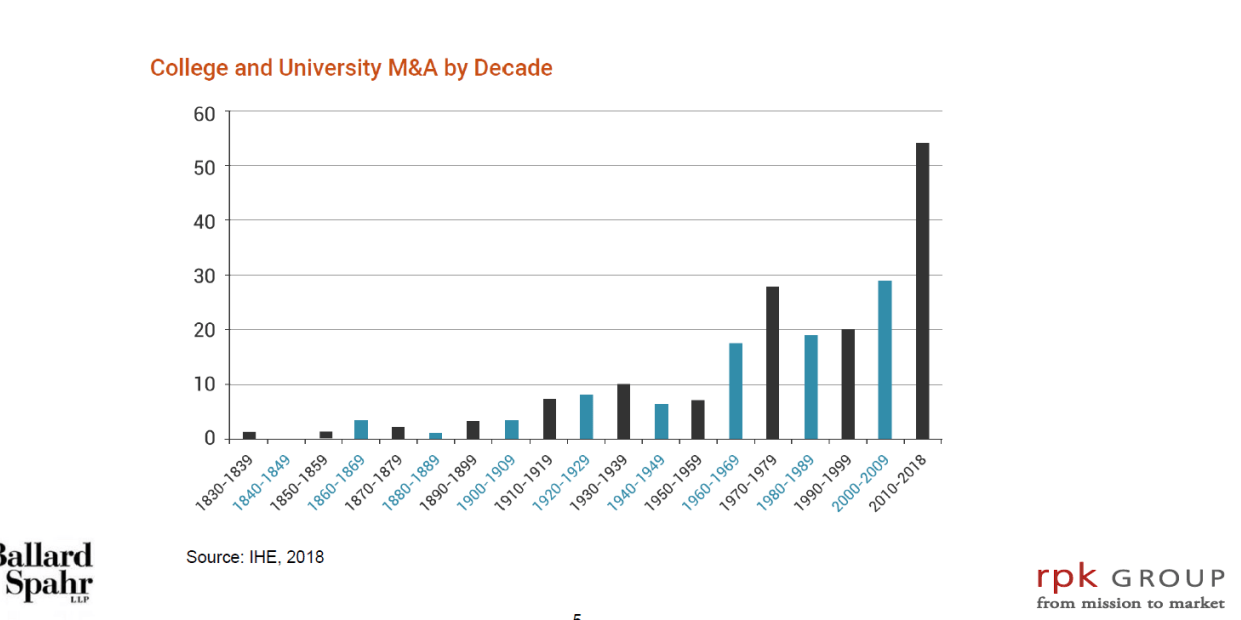This post first appeared on LinkedIn.
Strategic partnerships aren’t just taking place in company boardrooms.
Across the academic landscape, institutions of all sizes and Carnegie classifications are grappling with some significant strategic decisions—sometimes, these lead to the consideration of a strategic partnership, including a merger or an acquisition. Occasionally it’s a matter of survival (or a shutdown), and in other more positive scenarios, it’s a sign of growth and expansion.
You’ve undoubtedly read plenty of articles about higher ed institutions in the former situation—teetering on the brink of closure. In a recent webinar with the talented folks at Ballard Spahr, we covered how some college and university leadership teams find themselves creating a safe space to engage around many new forms of strategic partnership.
If you missed it, here are a few key points:
- Though still in the minority, mergers and acquisitions are on the rise in higher ed.
Trends are showing an increase in the number of mergers and acquisitions in higher education. Leaders need to acknowledge the role strategic partnerships can play in creating a sustainable business model that brings the mission forward in new ways.
- Before signs of major trouble appear, every institution should consider smart partnerships as part of its strategic plan.
Knowing what options and leverage they may have in advance could mean the difference between staying open or closing their doors.
- Institutions must intentionally create a safe space for conversation.
The consideration of strategic partnerships can feel uncomfortable for the senior leadership team and the board. Institutional and board leaders will need to create a safe space for these conversations. By normalizing the topic, leadership can ensure that candid conversations will be possible when the right opportunity arises.
- Strategic partnerships exist across a continuum.
Mergers aren’t the only solution. Institutional leadership has a number of options, including: consolidation, entering into a true merger, joining a conglomerate, becoming part of a consortium, undergoing an asset transfer, or embarking upon an affiliation. Some of these terms may be familiar; below I’ve provided definitions for each of these, in case any might be new to you.
- Consolidation: Two or more institutions are collapsed into a single new institution, usually with a different name, brand, mission, and scale of operation.
- True Merger: One institution is blended (merged) into a dominant institution, with that institution serving as the exclusive legal successor.
- Conglomerate: Without losing their institutional identities, two or more institutions enter a joint venture to address operational redundancies. The conglomerate has its own name and identity.
- Consortium: A collegial collaboration for common resource-sharing agreements—these often include cross-registration systems, joint libraries, shared facilities, common technologies, and shared operations.
- Asset Transfer: An institution transfers some or all of its assets to a second institution, which may provide for the continuation of the first institution’s programs.
- Affiliation: A joint venture, preserving identities and governance structures, but providing common academic programming or operational services.
- Be ready to do your homework.
Once institutions are ready to explore strategic partnerships, there is a clear due diligence process that should be followed. Its steps include:
- Setting strategy
- Identifying partnership possibilities
- Evaluating program fit/enhancement
- Itemizing assets and liabilities
- Determining market impact
- Maximizing efficiencies
- Reviewing legal aspects
- Ensuring regulatory/accreditation compliance
- Calculating transition costs
While that’s a robust due diligence list, here’s the good news: institutions can bite off smaller pieces along the way. For example, leaders can consider how a strategic partnership might fit with its strategy, and which strategic partners would be worth exploring. Stop! Until earlier critical steps are completed, there’s no need to move on to due diligence around program fit, etc.
- Find subject matter experts to help you navigate the process.
Moving through a consideration of strategic partnerships can seem daunting, both from a cultural and process perspective. Finding a good consulting and legal partner enables the board and senior team to fully engage in the process, while allowing the consultant and legal partner to support the design and facilitation of that process.
So, how has the strategic partnership process played out in the real world?
Where 1+1 Equals More Than 2 – Berklee College of Music, known for its celebrated jazz program, joined forces with Boston Music Conservatory, which focuses on classical training, to create Berklee. This merger allowed the institutions to better address the high costs associated with music education, while creating new program opportunities for all of their students.
Waiting Too Long – Mount Ida College provides a glimpse into a situation where negotiating power was lost. After a protracted period seeking out institutional partners, the leadership team found themselves in a disadvantaged state—at which point they were acquired by the University of Massachusetts system. This was purely an asset transaction, and no element of the institution remains. If Mount Ida had acted more proactively, might some semblance of their programs and their brand remain today?
Making the Hard Decisions – Boston University bought Wheelock College. Here, a larger institution acquired a smaller one, but the smaller institution’s legacy lives on. By actively seeking out partners while it still had value to bring to the table, Wheelock had more say in how its mission might be carried on. Today, the institution name and mission survive through the Wheelock College of Education and Human Development at Boston University.
Moving to New Markets – In a bold strategic move, Purdue University recently acquired Kaplan, a for-profit, major player in online education space—enabling the institution to launch revenue-producing programming through Purdue Global, an expanded online offering.
Higher ed has entered into a more precarious era, and we haven’t yet seen the end of colleges closing their doors. For many, however, strategic partnerships could be the springboard to a new future.
Missed the webinar and want to learn more? You can access it here: https://event.on24.com/eventRegistration/EventLobbyServlet?target=reg20.jsp&referrer=&eventid=2101045&sessionid=1&key=6B345161D0E27247AB6AD56191459DE0®Tag=&sourcepage=register
—
What conversations have you had with colleagues about strategic partnerships?
Does your team have a contingency plan that considers the above options?
Ready to discover more insights? Sign up to receive the monthly rpk Update.

